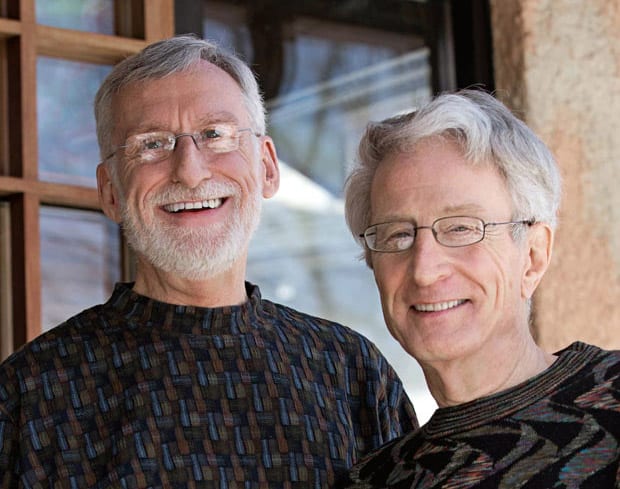The history of same-sex marriage is longer than you think; also, YA romance with a trans twist
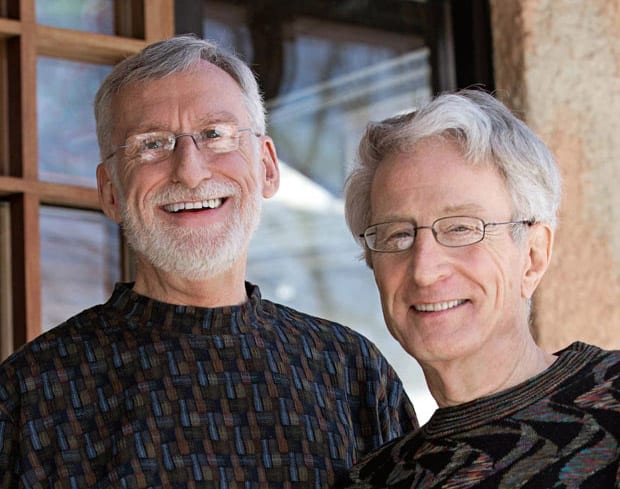
The Wedding Heard ‘Round the World by Michael McConnell with Jack Baker (as told to Gail Langer Karwoski) (University of Minnesota Press 2016) $22.95; 200 pp.
As a child playing with neighborhood girls, Michael McConnell remembers wanting the same thing they wanted: to grow up and marry a handsome man. Their crushes were his crushes, but in the 1950s, that kind of thing wasn’t discussed.
By the time he entered college at the University of Oklahoma in the mid-’60s, however, McConnell had come out to his family and was comfortable with his sexuality. He met other gay men and enjoyed an active social life on campus. Then, on Oct. 29, 1966, he met Jack Baker.
For the first minutes of their get-to-know-you, McConnell thought Baker was much older, or perhaps straight. Baker’s demeanor was businesslike, almost military; McConnell had recently had his heart broken, and was guarded. Still, by the end of the evening, they were lovers; soon after, they were a couple.
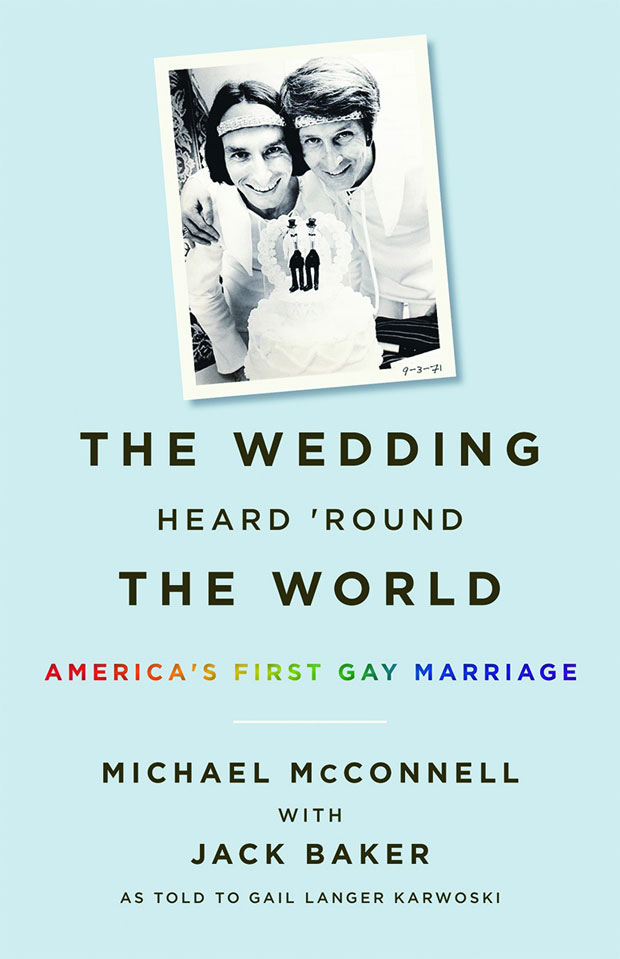 By the early ‘70s, though their relationship had to be kept quiet, McConnell and Baker were “out” enough to want to make real change. Baker, a Minneapolis law student, filed suit against the U.S. Department of Defense over an unfair downgrade in his discharge status. After following Baker north, McConnell fought job discrimination. And then there was the wedding Baker promised McConnell on Baker’s 25th birthday. It would happen — they just had to figure out how.
By the early ‘70s, though their relationship had to be kept quiet, McConnell and Baker were “out” enough to want to make real change. Baker, a Minneapolis law student, filed suit against the U.S. Department of Defense over an unfair downgrade in his discharge status. After following Baker north, McConnell fought job discrimination. And then there was the wedding Baker promised McConnell on Baker’s 25th birthday. It would happen — they just had to figure out how.
That would take some time, but Baker was on it. His legal training tickled his methodical mind, until he discovered two loopholes the state of Minnesota hadn’t closed. One led to the next, and both led to their history-making wedding in 1971.
That, of course, isn’t the end of the story. McConnell and Baker continued their activism but their nuptials — the first in America for same-sex celebrants — are the real focus in The Wedding Heard ‘Round the World. That’s a good thing, too, because the love story in this book is what makes it so readable. McConnell’s account is mostly what’s here, and it’s the quintessential romance: boy meets boy, boy marries boy, they live happily (almost) ever after.
Conversely, it’s the almost that makes this book so important: the battles the authors accepted caused emotional hardship in many ways and that almost caused a breakup.
And yet, for the sake of others that came after them, they continued to take on gay rights issues — stories of which are told humbly, yet proudly.
Overall, this is a sweet story wrapped inside a righteous fight, told with charm and grace. It’s deep, yet lighthearted and definitely worth a look. Start The Wedding Heard ‘Round the World — and you’ll have no defense.
What We Left Behind by Robin Talley (Harlequin Teen 2015) $18.99; 416 pp.
Years from now, it’ll all seem so sweet. There’ll always be a soft place in your heart for your first kiss, your first I-love-you, and for the person who gave them to you. You’ll never forget the electricity of holding hands or the rush of being together even after, as for instance in the novel What We Left Behind, you start to pull apart.
Gretchen Daniels wasn’t sure why she didn’t tell her girlfriend, Toni, that they’d be attending college in different cities. Last spring, Toni applied to Harvard and Gretchen applied to Boston University — same city, opposite ends — both reasoning that they could at least spend weekends together. At the last minute, though, Gretchen decided to attend NYU.
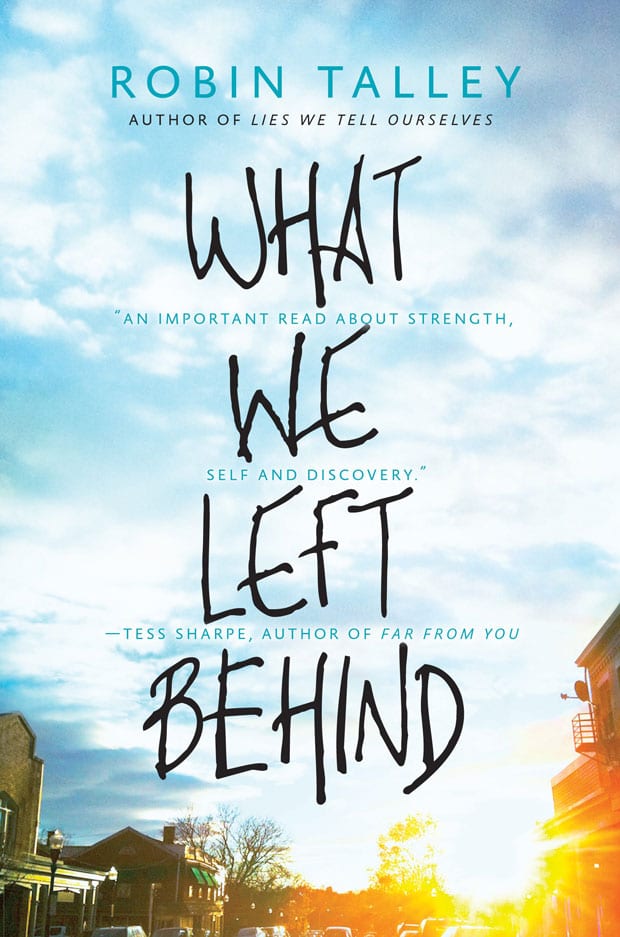 She didn’t tell Toni until the night before she left. They were juniors in their all-girl high school when Toni first saw Gretchen at a dance and was instantly in love. Everybody thought they were the cutest couple: Gretchen conferred upon Toni a new-found popularity. Toni taught Gretchen what it was like to be genderqueer — or at least she tried.
She didn’t tell Toni until the night before she left. They were juniors in their all-girl high school when Toni first saw Gretchen at a dance and was instantly in love. Everybody thought they were the cutest couple: Gretchen conferred upon Toni a new-found popularity. Toni taught Gretchen what it was like to be genderqueer — or at least she tried.
But the secret that Gretchen held all summer bugged Toni, and she was rightfully upset. She really didn’t have much to say to Gretchen, a silence complicated by Toni’s immersion into a campus group she joined. Freshmen weren’t allowed to be officers of the Undergraduate BGLTQIA Association but upperclassmen let her hang out with them and, under their tutelage, she began to explore labels for herself. She began to think about gender fluidity, and transitioning.
Toni’s lack of communication baffled Gretchen, and she discussed it at length with her new BFF, Carroll, a gay man who loved New York as much as Gretchen did. He was just one of the new friends she’d acquired, but she missed Toni and the closeness they had. She didn’t quite understand why Toni was questioning so much about herself, and she wasn’t sure how she’d fit in her girlfriend’s life if Toni became Tony. Would that change everything?
Better question: by the end of this book, will you care? I have my doubts.
What We Left Behind is very, very slow; in fact, it sometimes seemed to me that it was twice as long as its 416 pages of overly-detailed, same-old dialogue and young adults who were way too angst-y for my tastes. Yes, these kids do things that only increase the melodrama amongst themselves, which is ultimately not all that interesting but which creates an uneasiness in plot, making most of Talley’s characters mighty unlikeable.
And yet, I persevered. I was hoping to learn something from Toni’s gender-questioning. What I got instead was an abundance of language that seemed rather clinical and not always clear. Was that the point? Shrug.
Romance readers may find a tiny smidge of amour here, if they’ve the time to look for it, but I really wasn’t a big fan of this book. For the most part, best you just heed the title and leave this behind.
And West is West by Ron Childress (Algonquin Books of Chapel Hill 2015) $26.95; 320 pp.
Six degrees of separation. That, supposedly, is the difference between you and any given person on the planet. Your dentist, for example, knows somebody who knows someone who… and pretty soon, you’re linked to a famous scientist or Hollywood star. It’s a fun pastime, that Six Degrees thing, and surprisingly easy to do but in the novel And West is West, it could also be a deadly game.
Living with Zoe wasn’t originally Ethan’s desire. She’d stayed at his Manhattan condo many times — they were a couple, after all — but he was still surprised when he heard himself ask her to move in, and equally surprised that she agreed. Yes, he loved her, which was something he only truly realized just before she left for a job in D.C.
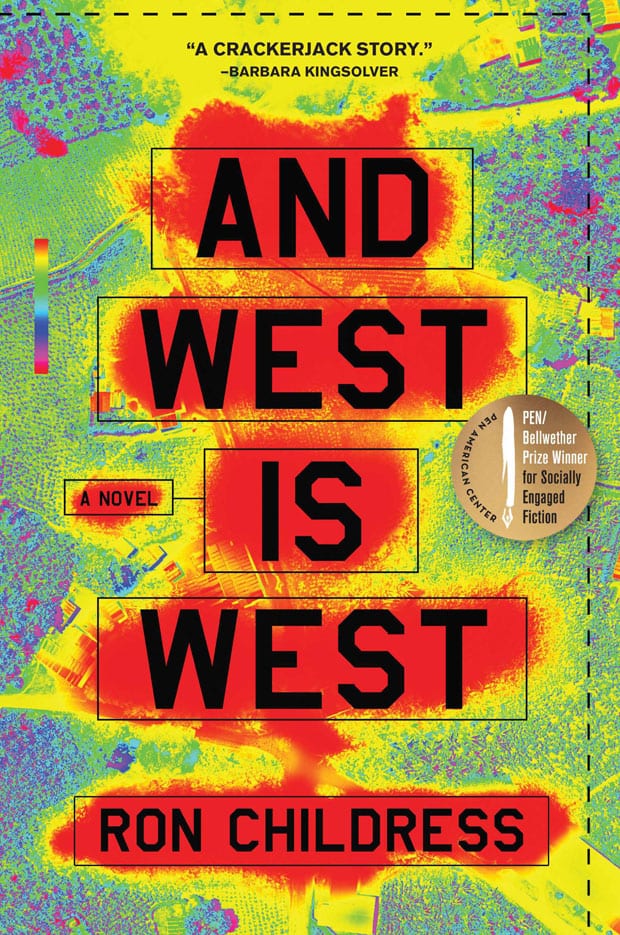 Heartbroken, Ethan turned to his other love: coding for United Imperial Bank. For him, it was the perfect job. UIB gave him an office and freedom to write algorithms to follow terrorists in order to follow the markets, creating serious money for Ethan and for his employers. That, plus Zoe, could’ve made him happy.
Heartbroken, Ethan turned to his other love: coding for United Imperial Bank. For him, it was the perfect job. UIB gave him an office and freedom to write algorithms to follow terrorists in order to follow the markets, creating serious money for Ethan and for his employers. That, plus Zoe, could’ve made him happy.
Except Zoe was gone, then someone set Ethan up to fail at work and his job was gone, too. And just as he thought things were looking up, Zoe was dead and Ethan was left holding the secrets of her life that her parents couldn’t tell her.
It always seemed as though Jessica Aldridge was running. She ran away from her mother’s alcoholism as a child. She ran away from family as a teen. She ran to the Air Force, where she became a highly-trained drone pilot but, since a remote strike had gone horribly wrong and someone had to take the fall for it, she ran from that, too.
But Jessica had just been following orders then. Her real mistake, she understood, was confiding her misgivings to the wrong person: her imprisoned father, whom she barely knew. She also understood that the government wasn’t going to take a breach of security lightly — and with the FBI on her tail, Jessica had to run again…
I have to admit that I was no big fan of And West is West when I started it. Its first few pages were more techy than I expected, and I wasn’t in the mood for that. Whoa, was I glad I stayed.
Once you get past the prologue, author Ron Childress takes readers in a whole different, unexpected direction with what seems like a profile of a psychologically flawed man. Ethan, in fact, is driven, indecisive, and so very imperfect — which makes him the perfect distraction from the page-ripping thriller that is Jessica. It seems unlikely, then, that the two are connected, but you’ll recall that six degrees stuff? Yep, and it doesn’t even take that many steps.
This is one of those keeps-you-up-at-night, miss-your-subway-stop kinds of books that you’ll pass around to friends. It’s one to take to your book club. For sure, And West is West is a solid 10.
Gay & Lesbian History for Kids by Jerome Pohlen (‘Chicago Review Press 2016) $17.95; 180 pp.
Knowing someone who’s gay, lesbian, or transgender is nothing new; in fact, history indicates that our earliest ancestors acknowledged and were comfortable with people we now call LGBT. Homosexuality appears in mythology, royalty, battlefields, art (Michelangelo and Leonardo da Vinci were said to be gay) and in some religions. In North America, many beloved 19th-century authors, poets and songwriters were gay or lesbian, and Native American culture embraced people who were of “two-spirits.” Transgender individuals fought in the Civil War or were pioneers or settlers. We know that LGBT individuals existed elsewhere and at other times, too, because laws were made against them.
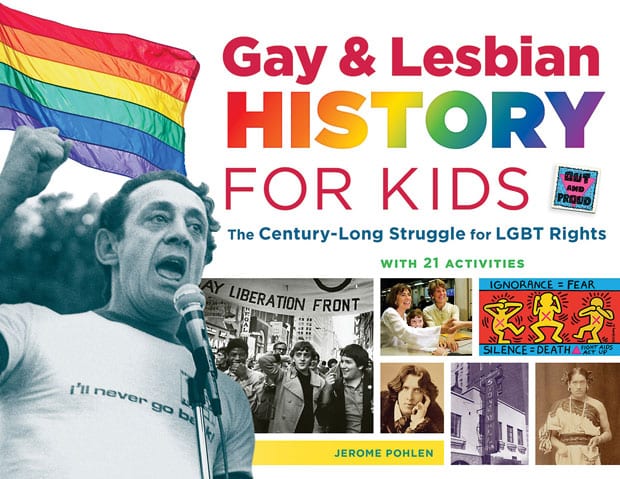
That was especially true through the early 1900s. Though we entered “the Progressive Era” in the beginning of the century, it was anything but progressive for people who were gay. When the country was stricken by the Great Depression in the 1930s, things got even worse for the LGBT community and many people had to hide their lives from mainstream society.
In some ways, things got better during World War II. The government needed military personnel and LGBT individuals, like everyone else, needed jobs, so they signed up in droves to fight for their country. Very few were denied a chance to serve but, sadly, after the war was over, many gay and lesbian personnel received “blue discharges,” and were denied veteran’s benefits. Once again, LGBT individuals needed to closet themselves and their lifestyles. Not doing so could mean arrest or worse.
Finally things started to turn around. Activism in the 1960s and ‘70s helped the LGBT community to gain rights and support on other issues, unfair laws were changed, and many people helped make things “get better.” All of which is fascinating information.
However I struggled with Gay & Lesbian History for Kids … though not for the reasons you might think. My biggest issue comes with its potential audience, vis-à-vis the content: mainly, that it contains either a lot of very advanced information for kids who are young enough to be excited about the “21 Activities” here; or a lot of silly, juvenile “activities” for kids who are old enough to handle very advanced information. Then, too, the presence of said activities may be moot, since they mostly had little to do with LGBT history.
To the positive, I appreciated the pre-20th-century info that author Jerome Pohlen offers; it was interesting, but is it enough to save this book? I don’t know: the target audience here is 9-and-up, which I think is way too young for the content. Fresh-eyed 12-to-15-year-olds may appreciate what’s inside, but hand it to a reader over 16, and the news probably wouldn’t be all that informative.
— Terri Schlichenmeyer



